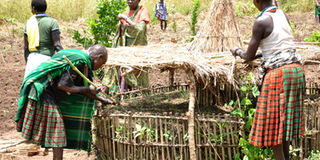Government to build lake to solve Karamoja’s food shortage

Farming. Karimojong women prepare a vegetable garden in an improvised shelter in Iriiri Sub-county Napak District on September 2 . PHOTO BY STEPHEN ARIONG
What you need to know:
- Government and GIZ have put aside Shs5b for feasibility studies.
- According to Mr Kizige, River Lopee was chosen for the project because it’s the confluence of all the water from Karamoja region before it crosses to the neighbouring Teso region where it often wreaks devastating havoc.
Kampala. At the launch of the annual National Physical Activity Day at Kololo Independence Grounds on July 8, President Museveni warned Ugandans that overeating was sending them early to the grave.
Mr Museveni cited the increasing cases of non-communicable diseases such as diabetes, cancer and high blood pressure, which he said are mainly caused by lifestyle behaviour and urged Ugandans to exercise and be careful about the food they eat.
“Avoid gluttony. Personally, I have heavy breakfast because it is what will run my body in the day’s course, have light lunch mainly to avoid ulcers and very little supper, eaten early in the evening,” he said.
“The increase in cases of cancer, diabetes, heart diseases especially in urban areas is because people eat too much and do not exercise,” he added.
This warning only applies to Ugandans in other parts of the country but not Karamoja where this year’s World Food Day celebrations will be held.
The celebrations are taking place in Lorengedwat, Nabilatuk District, under the theme: “A Zero hunger world by 2030 it’s possible”.
Like many residents in Karamoja, the head-teacher of Kalotom Primary School, Mr Mathias Kidon, has a daily hunger puzzle to solve for his school to continue running. Every term, the learners and teachers pray that World Food Programme will continue to feed them. Without United Nations (UN) help, Mr Kidon said children will not attend classes.
“They have some two meals a day and as a result they have strength [to sit in class]. In previous years, by 9am, a child is sleeping yet a teacher is expected to deliver content to such a child,” Mr Kidon said in a June interview.
The Uganda National Examinations Board has ranked Karamoja as the worst performing region in the country in previous national examinations. Negligence by parents and lack of food have been cited as some of the key reasons for the poor performance.
Mr Fred Angella, the Moroto Municipality MP, said often he is perplexed by how urban people especially in the capital Kampala waste food yet about 480km away in his constituency, people wake up without a clue where to get a meal.
It is not a one-time situation, but rather a chronic challenge that people in the sub-region have faced for decades without improved change.
“You plant this season, and you do not harvest anything. You plant another, you get nothing. This has made Karimojong disappointed and lazy,” Mr Angella said ahead of today’s World Food Day celebrations.
Karamoja, a vast-mineral rich region, is semi-arid and suffers long droughts every year and short rains. The region relies heavily on food aid mainly from donors.
“The President had promised that every district will have irrigation schemes and dams to provide water for farming. I do not know whether this is still a priority or not but if we had water, our people would not be suffering from hunger,” Mr Angella said.
The dry weather conditions in Karamoja have impeded its agricultural productivity, inhibited its economic potential and reduced it to only pastoralism as the main source of livelihood.
With climate change increasingly making the world drier, Mr Angella fears the worst may visit Karamoja unless government urgently addresses the traditional water scarcity problem in the region.
“It is not that we do not get rainfall at all. Heavy rains come once, flood and then stop. We need support to tap this water and use it later,” Mr Angella reasoned.
His argument is reinforced by observations of Ms Agnes Kirabo, the executive director of Food Rights Alliance, a civil society organisation in Kampala. “Is Karamoja drier than Egypt or Israel? But aren’t these countries feeding their people and exporting the rest to us?” Ms Kirabo posed a question that did not invite an answer.
“Karamoja is one of the most endowed regions in this country. Their soils are fertile and they have got different minerals. All they need is to be supported to access water some of which passes through their land from Mountain Elgon to South Sudan,” she added.
Mr Moses Kizige, the State minister for Karamoja Affairs, agreed that provision of water for irrigation would be a game changer in the region.
He said government has initiated a permanent solution and in the next five years, water scarcity will be a thing of the past. “We are going to construct a man-made lake at River Lopee. We expect to store a lot of water. This water will be used for irrigation,” Mr Kizige said.
He further explained that government and GIZ, a German development agency, have already put aside Shs5b to start feasibility studies to have the lake in place as soon as possible.
The man-made lake
According to Mr Kizige, River Lopee was chosen for the project because it’s the confluence of all the water from Karamoja region before it crosses to the neighbouring Teso region where it often wreaks devastating havoc.
“With that water, they will be able to produce crops all year without depending on unreliable rains and food aid,” Mr Kizige added.
He said the man-made lake will be linked to other water sources such as valley dams in all the Karamoja districts and government will continue to encourage the local population to grow drought-resistant crops such as sorghum and maize which shall be provided by government for early planting.
Early this year, WFP and the ministry of Agriculture and Agency for Technical Cooperation and Development, trained Karamoja pastoralists in agronomic practices, post-harvest handling and “how to do agriculture as a business” . This resulted in Karamoja’s first “export” of 98 metric tonnes of maize to WFP in memorable history.
“There are also some informal export of sorghum to Kenya by Karamoja. Karamoja will soon feed herself,” Mr Kizige said but warned that this year has been troublesome as there were heavy rains that washed away seeds.
The WFP Country Director, Mr El Khidir Daloum, however is optimistic that with a few initiatives, the chronic food scarcity in Karamoja will be cured or sufficiently mitigated.
“It is possible [to end hunger]. The green belts of Karamoja can produce food. It is just an issue of mindset,” Mr Daloum said after the UN agency bought 98 metric tonnes of maize from the local small scale farmers in Karamoja early this year.
The 98 metric tonnes of maize bought from Nakapiripirit and Napak districts.
He challenged residents to take advantage of the National Agricultural Advisory Services to grow more sorghum, maize and mangoes among other drought –resistant crops.
Mr Festo Tebanyang, a maize farmer in Nakapiripirit, said the World Food Day marked every 16 October, will give the local farmers opportunity to interact with traders from outside Karamoja and have prospects for good prices for their crops. “We shall share knowledge on how to improve on our agriculture because we are tired of surviving on handouts from NGOs,” he said.
Mr Tebanyang said handouts limit the amount and choice of food a family should eat, something that can only be solved if a family can afford its own food.
It remains to be seen whether today’s messages in Lorengedwat, where President Museveni is expected as chief guest, will result in tangible solutions to end Karamoja’s food stress. That will be every Karimojong’s hope.
The study
Warning. A study “The Impacts of climate change on food security and livelihoods in Karamoja sub-region,” conducted by the Ministry of Water and Environment and World Food Programme two years ago, warned that the region night plunge into a worse food crisis unless appropriate investment in water harvesting, agroforestry schemes, among others things, is made.
Every year, Karamoja is a permanent recipient of food aid. Sometimes aid delays leaving many people to starve to death. For instance, 46 people starved to death in 2013, with districts such as Kaabong, Napak and Moroto registering the highest fatality rates.




